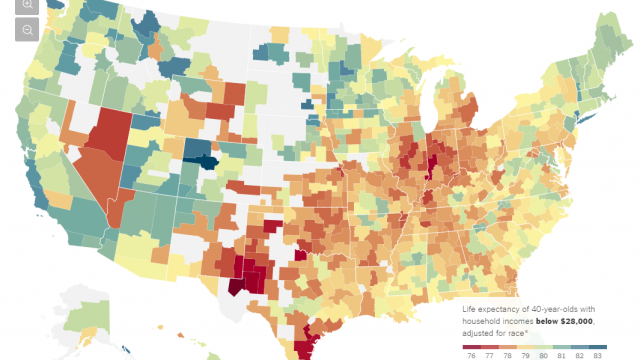Measured By Life Expectancy, North Dakota Is Not Such A Bad Place To Be Poor

The New York Times has published a map (see above) measuring the life expectancy of forty year old Americans with household incomes of less than $28,000 per year.
The results for North Dakota are pretty good. Data wasn’t available for the whole state (I suspect in the rural areas it was tough to put together a valid sample), but where it was North Dakotans should be happy with the results. Life expectancy rates for this demographic in the Dickinson, Jamestown, and Bismarck areas were above the national average. In the Fargo, Minot, Grafton, Grand Forks areas life expectancy was at about the national average.
The take away? Even poor North Dakotans can expect to live a lot of years.
More interesting is that while the story seeks to portray some dark commentary on the relationship between poverty and life expectancy, what we see is that things are generally pretty good for the poor – at least in terms of living long lives – even in those red areas.
[mks_pullquote align=”right” width=”300″ size=”24″ bg_color=”#ffffff” txt_color=”#000000″]More interesting is that while the story seeks to portray some dark commentary on the relationship between poverty and life expectancy, what we see is that things are generally pretty good for the poor – at least in terms of living long lives – even in those red areas.[/mks_pullquote]
For instance, in the Pecos area in Texas the life expectancy for this demographic is about 75.6 years. In the Fargo area, which is about at the national average, the life expectancy for this demographic is just a little over four years longer.
It’s hard to put a value on four years of life, but suffice it to say that this is not a terribly wide spread from one of the worst areas for life expectancy to the national average. Even the Dickinson area, which had a life expectancy well above the national average, was still just about six years longer than in Pecos.
I don’t want to trivialize six years of life, but a life expectancy of 75.6 years for even the poorest of Americans is pretty darn good. Especially when you consider that, back in the 1970’s, that was the life expectancy even affluent Americans could expect.
As to the reasons for these differences in life expectancy between rich and poor, I’m certain the most popular explanation in some political circles is that the rich have better access to health care.
That’s low hanging fruit for people who think we ought to have the government guarantee more access to health care, but I would suggest an equally important distinction between rich and poor.
More affluent people tend to make better life choices.
The sort of traits which lead to successful careers – self discipline, delayed gratification, long-term planning – can also, when applied to lifestyle choices, lead to healthier and longer lives.
Thus this is a social problem which, as so many do, comes down to personal choices.




